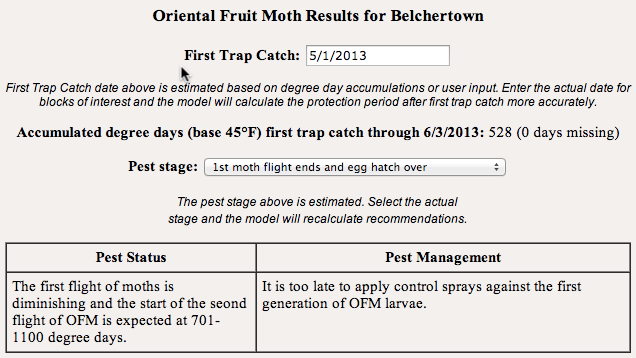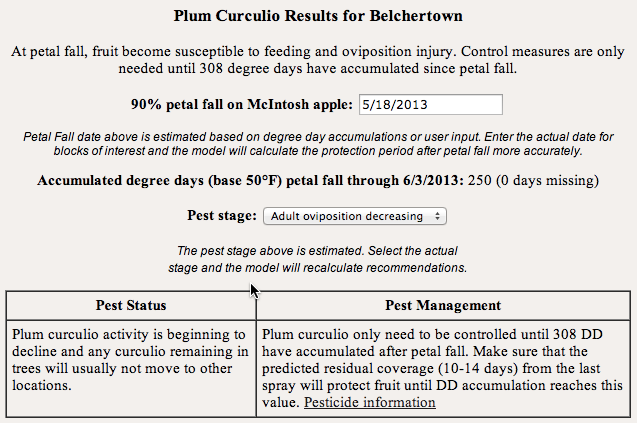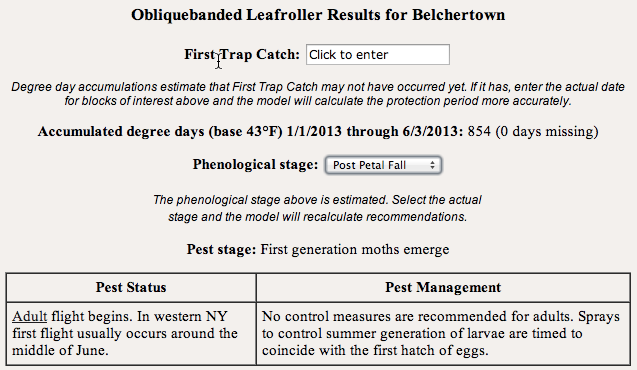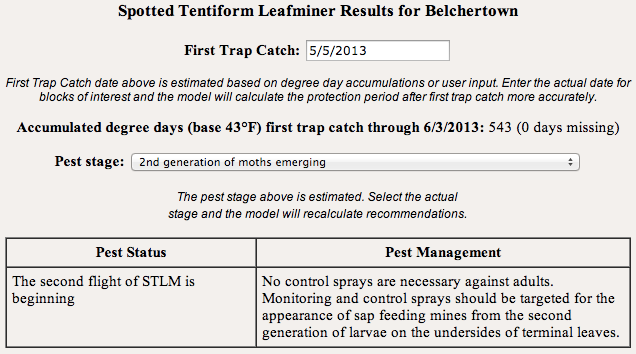

Current degree day accumulations
Orchard radar apple insect key dates
Location: UMass Cold Spring Orchard, Belchertown, MA
4-June, 2013 |
|
| Base 43 | 804 |
| Base 50 | 514 |
| Coming events | Degree days (Base 43) |
| Black cherry fruit fly first catch | 702-934 |
| Codling moth 1st flight peak | 571-999 |
| European red mite 1st summer eggs | 447-555 |
| European red mite summer eggs hatch | 737-923 |
| Lesser peachtree borer 1st catch | 485-683 |
| Oblique-banded leafroller pupae present | 601-821 |
| Redbanded leafroller 1st flight subsides | 589-899 |
| Pear psylla 1st summer generation adults present | 737-885 |
| Spotted tentiform leafminer 1st flight subsides | 674-956 |
Here are insect key insect dates from Orchard Radar, Belchertown, MA.
Codling moth (CM) 1st generation, first sustained trap catch biofix date: May 16, Thursday. Codling moth development as of June 4: 1st generation adult emergence at 52% and 1st generation egg hatch at 3%. In most orchards, insecticide targetted against plum curculio and apple maggot prevent codling moth damage. If targeted codling moth control is needed, key management dates are: 1st generation 3% CM hatch: June 4, Tuesday = target date for first spray where multiple sprays needed to control 1st generation CM. 1st generation 20% CM egg hatch: June 12, Wednesday = target date for first spray where one spray needed to control 1st generation CM.
Obliquebanded Leafroller (OBLR) 1st generation OBLR flight begins around: June 8, Saturday. Where waiting to sample late instar OBLR larvae is not an option (= where OBLR is known to be a problem, and will be managed with insecticide against young larvae): Early egg hatch and optimum date for initial application of B.t., Delegate, Proclaim, Intrepid, Rimon, Altacor, Belt, pyrethroid or other insecticide effective against OBLR (with follow-up applications as needed): June 25, Tuesday.
Plum curculio (PC) increased risk of PC damage as McIntosh and similar cultivars increase fruit size: May 22, Wednesday. Earliest safe date for last PC insecticide spray: June 7, Friday. If relying on repellance by Surround instead of PC mortality by insecticide, Surround coverage should be maintained until PC egglaying begins to naturally decline around Saturday, June 29.
European Red Mite (ERM) Optimum monitoring period for 2nd generation ERM: Friday, June 7 (nymphs hatched) to Friday, June 14 (egglaying starts for 3rd generation).
http://extension.umass.edu/fruitadvisor/upcoming-events
TUESDAY, June 11, 2013: Fruit Twilight Meeting, Tougas Family Farm, 246 Ball St., Northboro, MA. 5:30 PM. $20/25 meeting fee. 1 pesticide re-certification credit. Refreshments will be served. No pre-registration necessary. Special Guest, Win Cowgill, Rutgers University.
WEDNESDAY, July 10, 2013: Summer Meeting of the Mass. Fruit Growers' Association in cooperation with the University of Massachusetts Fruit Program, Honey Pot Hill Orchards, 138 Sudbury Rd., Stow, MA. 10 AM to 2:30 PM. For meeting flyer and registration info, click here: http://massfruitgrowers.org/2013/2013SummerMeeting.pdf
I am hitting it right with this week's HF because the weather is going to make my job easy. During the last week, we just got through one of the more difficult weeks probably in terms of disease and insect control, and fruit thinning. Hopefully everyone did their jobs and applied fungicides (primarily for apple scab, but also for rust, mildew, and fabraeae leaf spot) and insecticides (for plum curculio and codling moth) and fruit thinners (avoiding application during the worse heat) and everything is just settling in now this week. Plum curculio are still a bit of a concern but activity should be slacking off. Start scouting for scab lesions as they are showing up from previous infection periods. Last week I observed potato leafhoppers and associated foliar injury in a young planting in southwest Massachusetts, so keep an eye out for them and treat young plantings with insecticide as soon as any are observed. Finally, if you still need to do some apple fruit thinning -- but watch closely to see what might be coming off after last week's heat -- a good dose of Fruitone with Sevin is going to be necessary to get the job done this week.
As you can see below, no action currently needed for Oriental fruit moth (OFM).

As you can see below, the second generation of Codling Moth (CM) is making an appearance. Orchards with a history of CM problems (or any worm problems in fruit that you have not verified the identity of) need to take action soon. It may be a little too early to apply insecticides strictly targeting CM as plum curculio sprays still being applied should cover it. Otherwise, it will be a week or two before strict CM control will be necessary for those who need it.

Plum curculio (PC) are still an issue as seen below. I would wager that for most orchards insecticide coverage will be necessary through this week and then we should be out of the woods. By next week's HF we should be at 308 DD's.

We have not registered a trap catch in Belchertown yet of oblique-banded leafroller (OBLR). Once we do, the clock starts ticking towards the control window. No action needed now as seen below. (UPDATE: I just went out and checked the trap, and indeed there were a few OBLR. Biofix established and treatment clock starts ticking.)

I don't pay a lot of attention to Spotted tentiform leafminer (STLM) but if you have a perpetual problem with them, below is the current rough status. You would soon want to start scouting for sap feeding mines I suppose. Orchard Radar suggests 2nd generation adult flight has not started yet and sap feeding mines won't show up until early July though.

We should be at the end for apple scab as long as you have it under control at this point. There were three major infection periods: May 9-12; May 23-30; and just the past few days, June 2-3. Although the NEWA ascospore maturity models suggests that all ascopsores were released on May 22, don't count on it, you should have fungicide coverage in most cases through the past few days. It would have taken 4 well-timed fungicide sprays (IMHO) to control scab in Belchertown this year: a good protectant spray prior to the May 9-10; a protectant prior to May 23, and then some kickback by May 31; and a good protecant prior to June 2. That should have done it. How many times did you spray?

Just a note too that there has been some apparent phytotoxicity reported (coming out of Cornell/Hudson Valley) when Fontelis has been tank-mixed with Captan. Avoid that mixture for now until it gets sorted out.
Fire blight is pretty much a non-issue for most orchards now. Symptoms and strikes should be quite evident in susceptible orchards and cultivars by now if you did not apply streptomycin during bloom.
Regarding apple thinning, if you still need to do some, the carbohydrate models suggests you need to increase thinner rates by 30% this week. At this point, I would use 3-6 ounces of Fruitone-L plus 1-2 pints of Sevin per acre (depending on tree size and amount of thinning desired). It's pretty easy to see which fruit are coming off and which are staying based on growth rate and color of stem (yellow-pink are toast, green are probably staying) now.
Young apple tree leaders should be "stripped" now to maintain dominance of the leader as per below. Use your fingers or sharp hand pruners to pinch out/remove the competing shoots.
BEFORE stripping |
AFTER strippoing |
UMass Fruit Advisor: http://umassfruit.com
Scaffolds Fruit Journal: http://www.nysaes.cornell.edu/ent/scafolds/
Network for Environment and Weather Applications (NEWA): http://newa.cornell.edu
Follow me on Twitter (http://twitter.com/jmcextman) and Facebook (http://www.facebook.com/jmcextman)
UMass Vegetable & Fruit IPM Network (on Facebook, http://www.facebook.com/umassipmteam)
The next Healthy Fruit will be published on Tuesday, June 11 or thereabouts, 2013. As always feel free to get in touch with any member of the UMass Fruit Team (http://extension.umass.edu/fruitadvisor/team-members) if you have questions or comments.